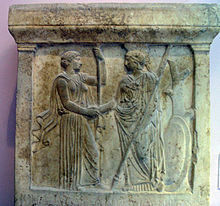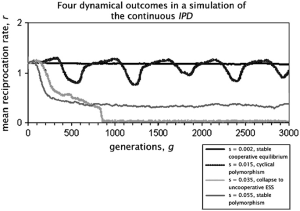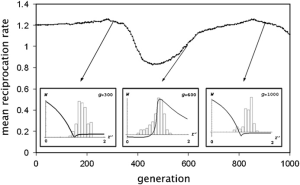隨著光線前進,
角膜→房水【前室】→虹膜【瞳孔】→晶狀體→玻璃體【後部】→視網膜
走到了能夠望遠觀近之
水晶體
水晶體,又稱晶珠,是眼球的主要屈光結構,也是唯一有調節能力的屈光間質;為一個雙凸形扁圓體,包以透明被囊[1][2]。
水晶體在角膜與虹膜之後、玻璃體與視網膜之前,其周緣部被水晶體懸器(睫狀小帶)繫於周圍的睫狀體,以固定其位置;水晶體懸器的緊張度受到睫狀肌的調節:懸器放鬆、被囊舒張,水晶體凸度增加,懸器和被囊緊張則水晶體凸度減小。
睫狀肌則由動眼神經調節,其調節能力隨著年齡的增長而逐漸降低 ,因而對遠近物體的調節力降低,形成老花現象。在假性近視中,睫狀肌常常過度收縮(痙攣),導致水晶體過凸,遠處物體的像形成於視網膜之前,無法看清[3][4]。
晶體的前凸曲率半徑為10mm,後凸曲率半徑為6mm,前後徑為5mm,直徑為10mm。
晶體由晶體囊、晶體上皮、晶體纖維和懸韌帶組成。
如果晶體由於各種原因造成其部分或全部混濁,引起視力障礙,此時瞳孔內呈白色,稱白內障。
水晶體的形成,為後來動物之視覺清晰度以致物種發展裨益莫大。
| 物件位置 | 遠 | 近 |
|---|---|---|
| 睫狀肌 | 鬆弛 | 收縮 |
| 睫狀體圓環直徑 | 大 | 小 |
| 懸韌帶張力 | 大 | 小 |
| 水晶體厚度 | 小 | 大 |
| 水晶體曲率半徑 | 大 | 小 |
| 折射程度 | 低 | 高 |
焉能不仔細端詳內蘊機理呢?
Lens (anatomy)
The lens is a transparent, biconvex structure in the eye that, along with the cornea, helps to refract light to be focused on the retina. The lens, by changing shape, functions to change the focal distance of the eye so that it can focus on objects at various distances, thus allowing a sharp real image of the object of interest to be formed on the retina. This adjustment of the lens is known as accommodation (see also below). Accommodation is similar to the focusing of a photographic camera via movement of its lenses. The lens is more flat on its anterior side than on its posterior side.
The lens is also known as the aquula (Latin, a little stream, dim. of aqua, water) or crystalline lens. In humans, the refractive power of the lens in its natural environment is approximately 18 dioptres, roughly one-third of the eye’s total power.
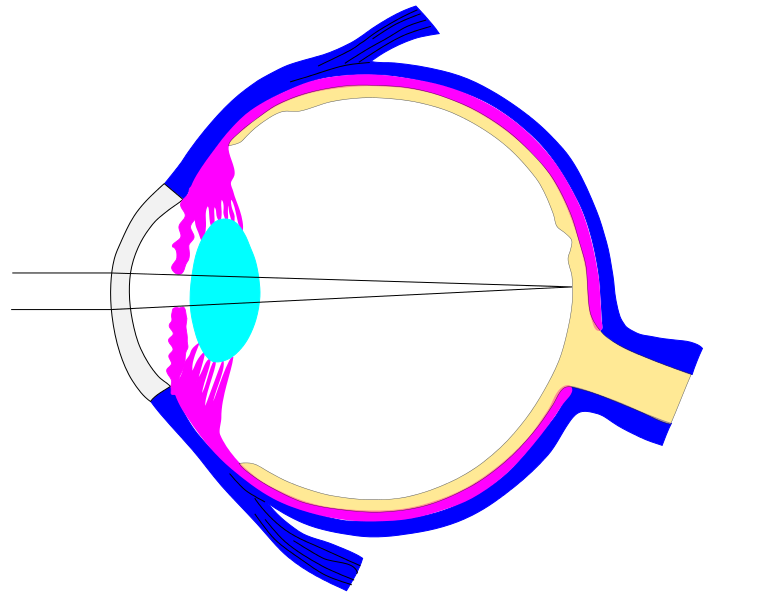
Structure
The lens is part of the anterior segment of the eye. Anterior to the lens is the iris, which regulates the amount of light entering into the eye. The lens is suspended in place by the suspensory ligament of the lens, a ring of fibrous tissue that attaches to the lens at its equator[1][2] and connects it to the ciliary body. Posterior to the lens is the vitreous body, which, along with the aqueous humor on the anterior surface, bathes the lens. The lens has an ellipsoid, biconvex shape. The anterior surface is less curved than the posterior. In the adult, the lens is typically circa 10 mm in diameter and has an axial length of about 4 mm, though it is important to note that the size and shape can change due to accommodation and because the lens continues to grow throughout a person’s lifetime.[3]
Function
Accommodation
The lens is flexible and its curvature is controlled by ciliary muscles through the zonules. By changing the curvature of the lens, one can focus the eye on objects at different distances from it. This process is called accommodation. At short focal distance the ciliary muscle contracts, zonule fibers loosen, and the lens thickens, resulting in a rounder shape and thus high refractive power. Changing focus to an object at a greater distance requires the relaxation of the lens and thus increasing the focal distance.
The refractive index of human lens varies from approximately 1.406 in the central layers down to 1.386 in less dense layers of the lens.[10] This index gradient enhances the optical power of the lens.
Aquatic animals must rely entirely on their lens for both focusing and to provide almost the entire refractive power of the eye as the water-cornea interface does not have a large enough difference in indices of refraction to provide significant refractive power. As such, lenses in aquatic eyes tend to be much rounder and harder.
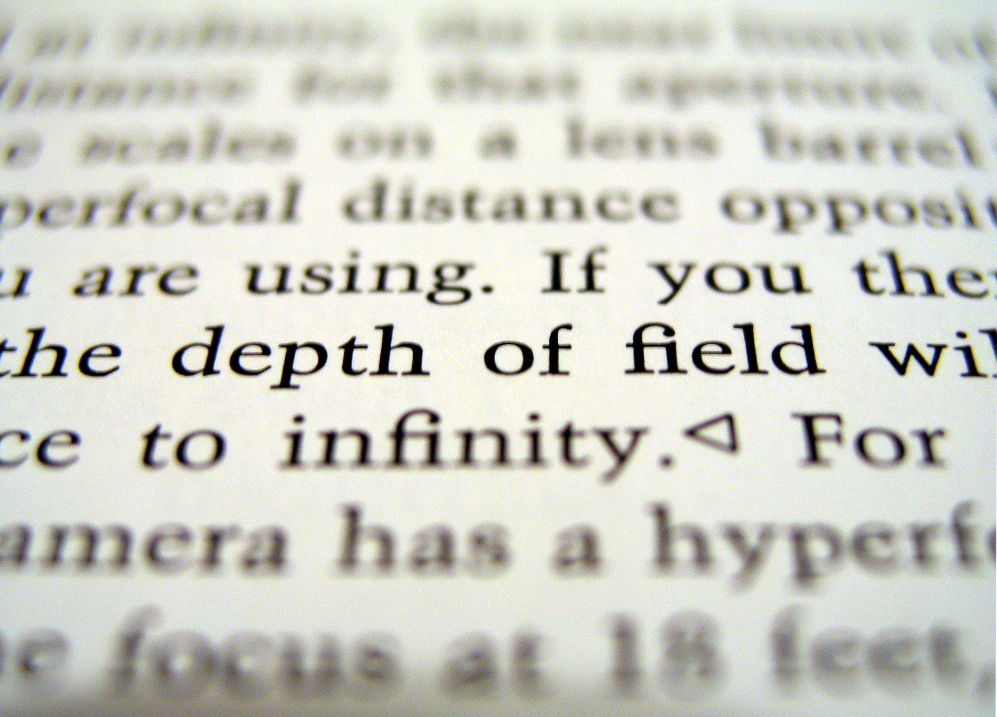
An image that is partially in focus, but mostly out of focus in varying degrees.
Crystallins and transparency
Crystallins are water-soluble proteins that compose over 90% of the protein within the lens.[11] The three main crystallin types found in the human eye are α-, β-, and γ-crystallins. Crystallins tend to form soluble, high-molecular weight aggregates that pack tightly in lens fibers, thus increasing the index of refraction of the lens while maintaining its transparency. β and γ crystallins are found primarily in the lens, while subunits of α -crystallin have been isolated from other parts of the eye and the body. α-crystallin proteins belong to a larger superfamily of molecular chaperone proteins, and so it is believed that the crystallin proteins were evolutionarily recruited from chaperone proteins for optical purposes.[12] The chaperone functions of α-crystallin may also help maintain the lens proteins, which must last a human for his/her entire lifetime.[12]
Another important factor in maintaining the transparency of the lens is the absence of light-scattering organelles such as the nucleus, endoplasmic reticulum, and mitochondria within the mature lens fibers. Lens fibers also have a very extensive cytoskeleton that maintains the precise shape and packing of the lens fibers; disruptions/mutations in certain cytoskeletal elements can lead to the loss of transparency.[13]
The lens blocks most ultraviolet light in the wavelength range of 300–400 nm; shorter wavelengths are blocked by the cornea. High intensity ultraviolet light can harm the retina, and artificial intraocular lenses are therefore manufactured to also block ultraviolet light.[14] People lacking a lens (a condition known as aphakia) perceive ultraviolet light as whitish blue or whitish-violet.[15][16]
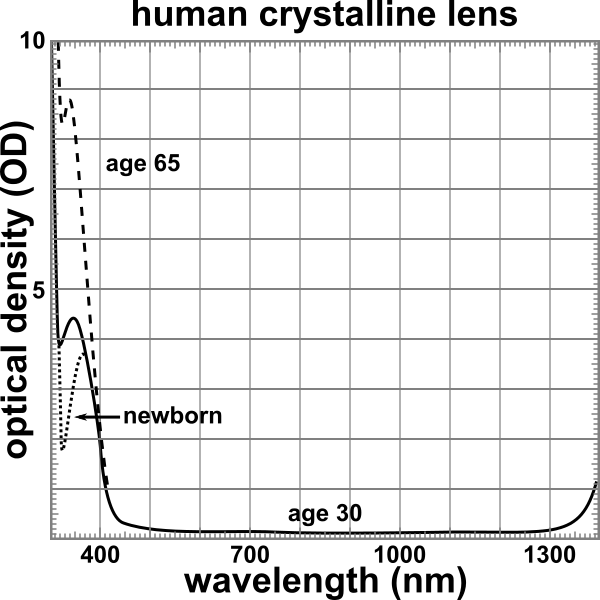
Graph showing optical density (OD) of the human crystalline lens for newborn, 30-year-old, and 65-year-old from wavelengths 300-1400 nm.
Nourishment
The lens is metabolically active and requires nourishment in order to maintain its growth and transparency. Compared to other tissues in the eye, however, the lens has considerably lower energy demands.[17]
By nine weeks into human development, the lens is surrounded and nourished by a net of vessels, the tunica vasculosa lentis, which is derived from the hyaloid artery.[7] Beginning in the fourth month of development, the hyaloid artery and its related vasculature begin to atrophy and completely disappear by birth.[18] In the postnatal eye, Cloquet’s canal marks the former location of the hyaloid artery.
After regression of the hyaloid artery, the lens receives all its nourishment from the aqueous humor. Nutrients diffuse in and waste diffuses out through a constant flow of fluid from the anterior/posterior poles of the lens and out of the equatorial regions, a dynamic that is maintained by the Na+/K+-ATPase] pumps located in the equatorially positioned cells of the lens epithelium.[5]
Glucose is the primary energy source for the lens. As mature lens fibers do not have mitochondria, approximately 80% of the glucose is metabolized via anaerobic metabolism.[19] The remaining fraction of glucose is shunted primarily down the pentose phosphate pathway.[19] The lack of aerobic respiration means that the lens consumes very little oxygen as well.[19]
因是問此見微知顯晶珠,到底為何而生的乎??
《論語‧憲問第十四》
或曰:『以德報怨,何如?』子曰:『何以報德?以直報怨,以德報德。』
一九八四年,美國政治學家羅伯特‧阿克塞爾羅德 Robert Marshall Axelrod 寫了一本《合作的進化》 The Evolution of Cooperation 的書,探討有著『記憶』與『重複』發生的『囚徒困境』,將之稱為『重覆囚徒困境』 IPD iterated prisoners’ dilemma。在此博弈中,參賽者須反覆選擇彼此競合有關的策略,記住之前的結果。阿克塞爾羅德邀請全世界的學術同行來參與設計電腦策略程式,並在一個 重覆囚徒困境競賽中互相競爭。 參賽的程式的差異在:演算法的複雜性、最初的對抗、寬容的能力種種方面。
據聞,最佳策略是『以牙還牙』,它是由俄裔美籍數學心理學家阿納托爾‧拉波波特 Anatol Rapoport 所設計的策略。這個程式僅僅只有四行 BASIC 語言陳述句,而且贏得了比賽。這個策略選擇先合作,然後採取對手前一回合的策略。有人說,更好一些的策略是『寬容的以牙還牙』。當你的對手背叛時,在下回合中你應該要『擲筊』偶爾【1%-5 %機會】合作一下。這是為了避免『死結』,萬一雙方誤解了對方的意思該怎麼辦的呢??
阿克塞爾羅德發現,當這種『對抗』被各種策略的參與者一再重覆了很長時間之後,從『利己角度』來判斷,最終『貪婪策略』趨向於減少,繼而比較『利他策略』更多的被採用。他用這個『博弈』來說明,經過『自然選擇』,一種『利他行為』之機制可以從最初『純粹自私』的機制進化而來!!當有了『記憶』,『背叛』恐將遭到『懲罰』時,所謂的『利己』必將思及『因果』效應的吧!
之後『重覆囚徒困境』的『合作‧背叛』二元合作模型,被廣泛的應用於『生物』與『社會』科學中。然而由於『自然選擇』這種『利他行為』,實在『美好的難以置信』,因此『質疑』的聲浪漸起。二零零三年,Peter Hammerstein 編輯了一本 MIT 出版的《Genetic and Cultural Evolution of Cooperation》,……
Hammerstein 問著︰
Why is reciprocity【互惠】so rare【罕見】 in social animals【社交動物】? A protestant appeal. 【宛如新教呼籲】??
二零零六年,美國加州大學人類學家 Stephen Le 和 Robert Boyd 寫了《Evolutionary dynamics of the continuous iterated Prisoner’s dilemma》一篇論文,探討『連續選擇』 ── 從『背叛』 ![]() 到『合作』
到『合作』 ![]() ── 的 IPD 可能發生的現象。他們使用電腦模擬的結果發現,事實上,想要產生『互惠行為』,不是如二元『重覆囚徒困境』所說的那麼樣『容易』,用他們論文『摘要』中的話講︰
── 的 IPD 可能發生的現象。他們使用電腦模擬的結果發現,事實上,想要產生『互惠行為』,不是如二元『重覆囚徒困境』所說的那麼樣『容易』,用他們論文『摘要』中的話講︰
The continuous model outlined here suggests that incremental amounts of cooperation lead to rapid decay of cooperation and thus even a large degree of assortment will not be sufficient to allow cooperation to increase when cooperators are rare. The extreme degree of assortment required to destabilize the non-cooperative equilibrium, as well as the instability of the cooperative equilibrium, may help explain why cooperation in Prisoner’s Dilemmas is so rare in nature.
─── 摘自《物理哲學·下上》
繼而想宇宙果有真無人擇原理耶!!
在我們的地球上,有著各種不同的『能量形式』,廣泛的存在於『物理』、『化學』和『生命』現象之中。雖說知道『基本粒子』構成了『原子』,『原子』的結合成了『分子』,『巨大分子』的『複雜系統』形成了『生命現象』,然而該講對於這些不同種類的『交互作用』,人類所知還是很有限的。因此就有人議論著︰是否所有的的『生命現象』都可以『還原』成『理化現象』,因此可以用『物理』和『化學』的『術語』來『定義』與『解釋』的呢?在一九七三年澳洲天體物理學家布蘭登‧卡特 Brandon Carter 於紀念『哥白尼』誕辰五百周年的『宇宙理論觀測數據』會議上,站到了『哥白尼原理』的反面,他主張︰
正如哥白尼原理否認了人類在宇宙中的特殊地位,也如同哥白尼所主張的,地球並不是宇宙的中心,而且太陽也不過是一顆位於典型銀河系的典型恆星。雖然我們所處的位置不一定是『中心』,但是無法避免的,在某種程度上處於特殊的地位。───《大數重合 與宇宙論中的人擇原理》論文。
『人擇原理』Anthropic principle 有強、弱各種不同版本,贊成與批評的聲浪始終不斷。在此僅僅引用一九八六年約翰‧巴羅 John Barrow 和弗蘭克‧蒂普勒 Frank Tipler 所合著的《The Anthropic Cosmological Principle》書中寫的弱人擇原理︰
自然定律驚人地適合生命的存在。
物理學和宇宙學的所有量的觀測值,不是同等可能的;它們偏愛那些應該存在使碳基生命得以進化的地域以及宇宙應該足夠年老以便做到這點等等條件所限定的數值。
假使衡量『達爾文』的『生物進化』中的『物競天擇』原理,那麼從『微觀』理化系統的觀點上來說,是否已經發現一種理化作用『機制』,來說明『遺傳』現象的呢?與其說『DNA』與『RNA』解釋了許多『生命現象』,而它的『由來』只是因原子和分子長遠時間以來理化上的『隨機組合』就能夠產生的嗎??就像在『量子力學』的發展之初,物理學家也不知道『基本粒子』可以區分為『費米子』 ── 比方說電子、質子和中子 ── 與『玻色子』 ── 例如光子和胶子 ──,在那之前也當然就沒有『費米子』的『泡利不相容原理』Pauli Exclusion Principle。這一切都是來自於『物理現象』的『實驗』與『觀察』,或許說『宇宙的探索』人類才剛踏出『一小步』,無怪乎一個『巧合』處處的宇宙,引發了人們『議論』紛紛!!
─── 摘自《【Sonic π】電聲學補充《一》》


